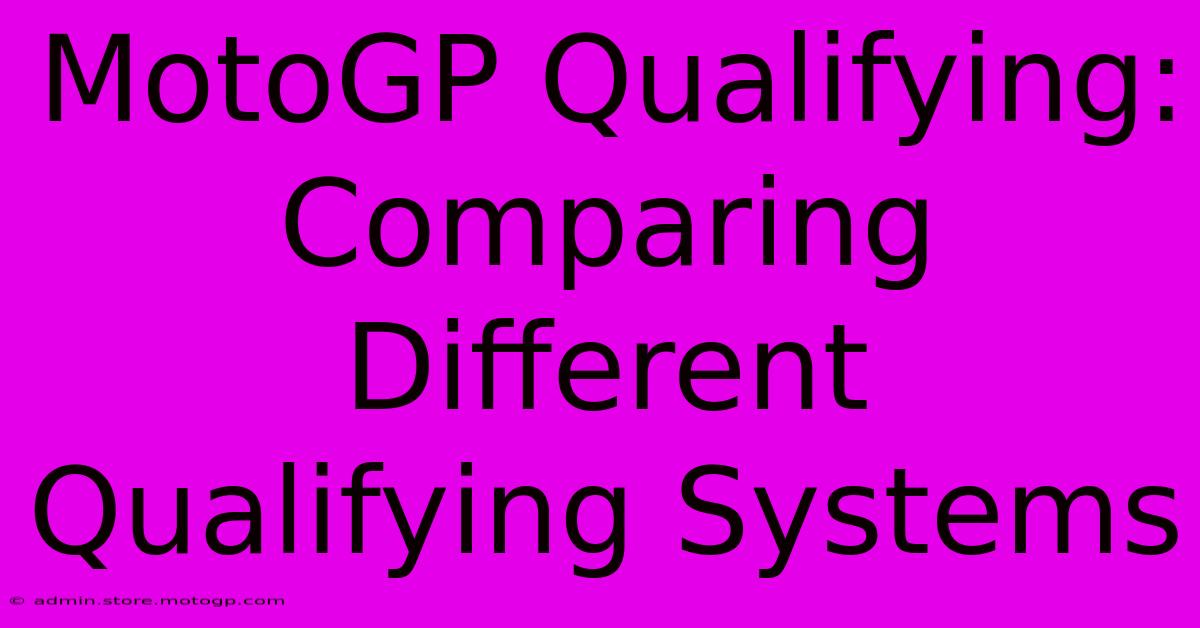MotoGP Qualifying: Comparing Different Qualifying Systems

Table of Contents
MotoGP Qualifying: Comparing Different Qualifying Systems
MotoGP, the pinnacle of motorcycle racing, has seen several iterations of its qualifying system over the years. Understanding these changes is key to appreciating the current format and the strategic nuances it introduces. This article compares different MotoGP qualifying systems, analyzing their strengths and weaknesses.
From Simple to Complex: A History of MotoGP Qualifying
The early days of MotoGP qualifying were relatively straightforward. A single practice session determined the grid positions, often leading to a chaotic scramble for the best starting spots. This lacked the drama and strategic depth we see today.
The Single Qualifying Session Era: Pros and Cons
Pros:
- Simplicity: Easy to understand and follow for both racers and spectators.
- Direct Competition: One session meant all riders were competing directly against each other.
Cons:
- Lack of Strategic Depth: No room for nuanced race strategies based on qualifying performance.
- High Risk: One bad lap could ruin the entire race weekend.
- Less Predictability: Results were less predictable, often influenced by factors beyond rider skill.
The Introduction of Q1 and Q2: A Turning Point
The introduction of a two-part qualifying system, Q1 and Q2, significantly altered the MotoGP landscape. This format, still used today, separates riders based on their performance in the initial qualifying session, leading to a more refined grid.
The Current Q1 and Q2 System: Advantages and Disadvantages
How it Works:
The fastest riders from FP3 (Free Practice 3) progress directly to Q2. The remaining riders compete in Q1, with the fastest two riders advancing to join the Q2 group. Q2 sets the grid positions for the race.
Pros:
- Increased Strategic Depth: Teams can develop different qualifying strategies based on their riders' capabilities and track conditions.
- More Predictable Results: While still subject to variables, the two-stage process leads to a more ordered and competitive grid.
- Fairer Competition: Gives riders who might struggle in FP3 a chance to improve their position.
Cons:
- Increased Complexity: Can be less easy for casual fans to understand.
- Pressure in Q1: Riders in Q1 are under immense pressure to make the cut.
- Potential for Accidents: Increased competition in Q1 can lead to more incidents.
Exploring Alternative Qualifying Formats: Hypothetical Scenarios
While the current Q1 and Q2 system is effective, other approaches could be considered. Imagine:
A Reverse Grid System for Q1: A Proposal for More Excitement
Imagine Q1 determining the grid for a sprint race on Saturday afternoon. The top finishers in the sprint then form the front row of the grid for Sunday's main race. This adds a huge element of unpredictability and excitement.
Potential Benefits:
- Increased Fan Engagement: A more captivating spectacle to watch.
- Leveling the Playing Field: Less dominant teams might have a greater chance to shine.
- More Dramatic Races: This could lead to more exciting races.
Potential Drawbacks:
- Risk of Injury: More intense racing may mean more accidents.
- Impact on Championship: Could distort the true reflection of skill and performance.
Conclusion: The Evolution of Qualifying
The evolution of MotoGP qualifying showcases a constant effort to improve the racing experience for both participants and spectators. The current Q1 and Q2 system balances fairness, competition, and strategic depth. While alternative systems like a reverse grid for a sprint race could add more excitement, changes must carefully consider the overall impact on the championship and safety of riders. As the sport continues to evolve, it will be fascinating to see how MotoGP qualifying adapts and innovates in the future.

Thank you for visiting our website wich cover about MotoGP Qualifying: Comparing Different Qualifying Systems. We hope the information provided has been useful to you. Feel free to contact us if you have any questions or need further assistance. See you next time and dont miss to bookmark.
Featured Posts
-
Moto Gp Bike For Sale Where Power Meets Precision
Feb 18, 2025
-
Cota Qualifying Conquer Your Fears Conquer The Track
Feb 18, 2025
-
Cota Qualifying Is This Your Year
Feb 18, 2025
-
Moto Gp Race Tracks Understanding The Technical Aspects
Feb 18, 2025
-
Motorcycle Racing A Journey Of Discovery
Feb 18, 2025
